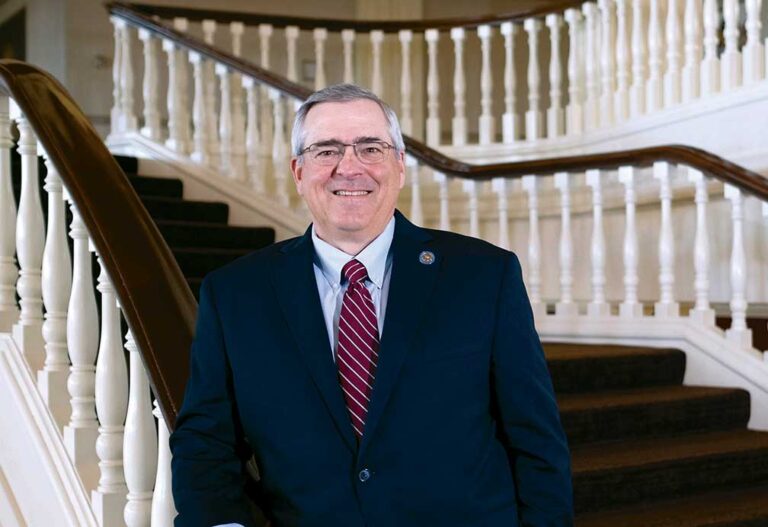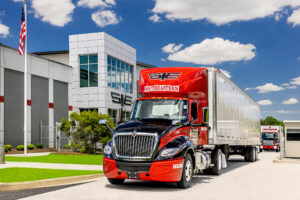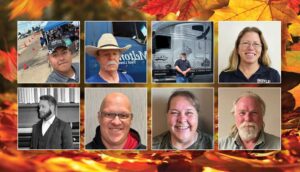On March 26, 2024, during the closing banquet of the Truckload Carriers Association’s (TCA) annual convention, John Culp, president of Arkansas-based Maverick Transportation, officially stepped into the role of the association’s chairman.
As he stepped to the podium, he thanked outgoing chairman Dave Williams for his service, noting that Williams “set the bar high” during his tenure. Culp continued, sharing thoughts about the value TCA brings to its members, including the group’s power as advocates for the truckload industry on Capitol Hill.
“It’s an ongoing team effort for our staff, our members, and our lobbyists. Together, we are making a difference,” he noted, urging any members who have not participated in TCA’s annual Call on Washington to add their voices to this year’s efforts. Outlining goals for the coming months, he touched on numerous issues facing the industry. In closing, he noted that industry leaders should invest in their greatest assets.
“We all have big investments in rolling stock buildings, computers, and technology, but our most important asset is our people — more importantly, our people working as a team is what makes us successful,” he explained. “In my opinion, investing in our people is more than just time and money well spent; it’s critical for building the foundation for continued success in the future.”
Linda: First of all, congratulations on stepping into your new role as TCA chairman! What does this new responsibility mean to you, both personally and professionally?
John: Thank you, Linda. It’s an honor to have the opportunity to serve as TCA’s chairman. Dave Williams leaves big shoes to fill, but our association is in great shape, and our officers and staff are aligned and on board with the vision and objectives we’ve been working on for the past several years. We don’t need to change what we’re doing, but we know we can get better and that is what we want to do.
Linda: You were formally introduced as this year’s chairman during TCA’s 2024 convention in Nashville just a few weeks ago. How did it feel to step up to that podium, look out at the association’s members, and realize that all those people will be looking to you for advice, opinions, and solutions during your tenure as chairman?
John: It felt good to see a full house. Our annual conference attendance has been growing over the past several years, and it was great to see so many people staying for the closing banquet. My position responsibilities are changing, but we have a great staff and officer group and we work together as a team in everything we do. I anticipate business as usual for Team TCA.
Linda: For members who haven’t had a chance to get to know you yet, how and when did you first become interested in the trucking industry?
John: I had been working in public accounting for a couple of years after graduating college when I decided I wanted to move to the private sector. The first opportunity I had was with Chandler Trailer Convoy, a small carrier in Little Rock, Arkansas. I made a couple of moves for better opportunities with other trucking companies in town before I found my dream job at Maverick. I learned a lot at every company I worked for and am still grateful for the opportunities I had. I guess it is safe to say that trucking has been my career of choice since I was young and green between the ears.
Linda: When did you first start working for Maverick, and in what capacity? What roles have you held with the company?
John: I joined Maverick in September of 1989 as vice president of finance and became part of the company’s four-person officer group. We had 70 company trucks and 26 owner-operators at the time. The only other position I have held since then before becoming president was executive vice president and CFO.
Linda: How long have you been part of TCA, and what roles have you held within the association?
John: I don’t remember exactly the first time I attended a TCA conference, but it was sometime in the mid ’90s. Maverick’s founder, Steve Williams, felt it was important for our leaders to become involved in state and national trucking organizations for educational purposes and industry knowledge — but also to be actively involved in the efforts of these organizations to make our industry and our company better. I have served in various positions in other associations, but my first role at TCA began when I became an officer in 2019.
Linda: In your opinion, how do industry associations like the TCA benefit their members? The industry as a whole?
John: For our members at TCA, we have a value proposition matrix of five key objectives that form the foundation of our efforts to deliver membership value:
- Improving the driving job;
- Improving roadway safety;
- Improving financial sustainability for our member companies;
- Improving our industry image; and
- Promoting industry environmental stewardship.
In each of these areas, we provide a combination of meetings, events, programs, and educational opportunities designed to provide value for the dues members pay and the time they invest in TCA.
For me personally, the most valuable and rewarding benefit of TCA membership is networking and developing relationships with peers and vendors. It’s helped me tremendously in my career and I feel it has made me a better leader. But the icing on the cake has been the incredible friendships I have made, and with that, I have been truly blessed.
For our industry, I would say that our advocacy efforts on The Hill to address the important issues that impact our industry would be the biggest value. Our voice is strengthening, and we have plenty of issues to work on.
Linda: In your opinion, what is the biggest issue faced by the industry today, and what are some possible solutions?
John: I really worry about the ever-increasing cost of liability insurance. Both trucking and insurance companies alike are fighting nuclear verdicts that are unsustainable. As an industry, we must lead the charge for lawsuit reform, state by state, to place reasonable limits on non-economic damages for parties injured in accidents. As an industry, taking responsibility for injuries we cause is the right thing to do. Every trucking company should carry adequate insurance to do so; we are not trying to change that, but today’s out-of-control “jackpot justice” is simply wrong and needs to be addressed.
Linda: Emissions regulations calling for the trucking industry to convert to zero-emissions trucks remain a hot topic. Many groups appear to promote battery-electric vehicles across the board, while some suggest other options, such as hydrogen fuel cell batteries or diesel engines powered by renewable natural gas. What are your thoughts on the proposed timeline for zero emissions and the available options?
John: Short answer: It is unreasonable and unrealistic to reach the zero-emissions targets that have been laid out for our industry. TCA supports zero-emissions for trucks, but it is going to take a long time. We need commonsense leaders to realize this and set realistic timelines with an affordable path.
A recent independent study by Roland Berger, a global consulting company, estimated the cost to build the electric grid needed to charge an all-electric truck fleet in the United States is $1 trillion. For most people, that is “monopoly money,” because it is hard to comprehend exactly how much that is. One trillion is one thousand times a billion. We have approximately 333 million people in the US. That equates to a cost of $3,000 for every person in the country. That’s a lot of money, and it is real.
TCA has been a founding partner in the Clean Freight Coalition in its effort to advocate for sound public policies that transition toward a zero-emission future in a manner that strategically assures affordable and reliable freight transportation and protects the nation’s supply chain. If you want to know more, please feel free to visit cleanfreightcoalition.org.
Linda: It’s now been nearly four-and-a-half years since the FMCSA launched the Drug and Alcohol Clearinghouse as a national database for the results of commercial drivers’ drug and alcohol screenings. In your eyes, how has having access to this information changed the face of driver recruitment and retention?
John: The Clearinghouse has been very effective in removing drivers who have tested positive for drug and alcohol violations from our highways. The change in driver recruitment is a big win for trucking companies in that drivers are no longer able to beat the system when they fail a drug test at one carrier and later fly under the radar with another company. I don’t think any carrier wants to hire a driver who has failed a drug test.
The only problem I know of with the Clearinghouse is that the FMCSA still won’t allow companies that utilize hair follicle testing to report their results to the Clearinghouse.
Linda: That leads us straight to my next question: Even though proposals to allow alternate forms of testing, such as oral fluids and hair follicles, have been introduced, no clear decision has yet been made. How would allowing the use of such testing impact the driver workforce?
John: Maverick is part of a group of carriers that have been utilizing hair testing for years. Out of 460,568 drivers who underwent both hair follicle and urine testing from 2017-2022, we have personal knowledge of positive drug tests for 23,601 drivers who passed urine tests at the same time. That means 23,601 habitual drug users were likely able to immediately go to work for a carrier that does not utilize hair testing. Hair follicle testing identifies drug users nine times more effectively than urine testing. Researchers estimate that if that rate were applied to the entire truck driver population, it is reasonable to estimate that up to 250,000 drivers who passed a urine test would have failed a hair test at the same time.
Congress passed the FAST Act in December of 2015, directing the Department of Health and Human Services (HHS) to write the guidelines for hair follicle testing to enable the FMCSA to add it as an approved testing method for DOT compliance. Since then, HHS has delayed the process, blocking the ability for companies that utilize hair testing to submit known positive drug tests to the Clearinghouse.
Why, you ask? They claim they have concerns the test may be racially biased — but there is no research to verify it. On the other hand, a study analyzing over 70,000 drivers where ethnicity information from hair testing data was available determined hair follicle testing is not racially biased.
It seems to me the powers that be at HHS don’t care when carriers must let someone we know has tested positive for opioids or fentanyl go unreported to the Clearinghouse and be able to go to work for a company that does not hair test. For me personally, it is infuriating when we have to let that happen! It is irresponsible for the government agencies responsible for the safety of our motoring public to sit on their hands for nine years and continue to do nothing.
For the record: TCA supports carriers’ ability to submit hair test results into the Clearinghouse.
A University of Central Arkansas study came to the following conclusion regarding a person’s race as it pertains to hair follicle testing:
“Utilizing independently provided urine and hair pre-employment drug screen data, Researchers were unable to find disparate impacts of hair testing among the ethnic groups analyzed. Results for each test in each sample met the required Four-Fifths Rule threshold. Chi-square tests independently examine urine and hair tests. Chi-square results indicate that the proportion of drug test failures (positives) are higher for hair testing across all ethnic groups, but pass/fail rates are significantly different irrespective of testing method. Given these findings, Researchers find no disparate impact among ethnic groups by testing method.”
Linda: Here’s another related question: While the federal government has not changed its policies on the use of cannabis products, many states have legalized the drug for both medicinal and recreational use, creating yet another hotbed issue for the trucking industry. What are your thoughts on this?
John: The problem with cannabis is very real. Usage is increasing, and there is no way to test for real-time impairment that law-enforcement officers can use like they can with alcohol. Until there is, the problem will continue to grow. Hair follicle, urine and oral testing can detect THC in a driver’s system but not impairment at the time of the test. At a minimum, until impairment can be measured, cannabis needs to stay a Schedule 1 drug for all drug tests for drivers.
Linda: Let’s take a look at another topic the trucking industry is watching closely. In 2021, the Modern, Clean, and Safe Trucks Act reintroduced industry efforts to repeal the federal excise tax (FET) on heavy-duty trucks and trailers. Since then, both House and Senate versions of the bill seem to have stalled out in committee. Do you predict any movement on these measures over the next year? Why or why not?
John: Unfortunately, no. The FET is an outdated tax that goes up every year as tractor and trailer prices go up. And, with the cost to purchase new equipment being at an all-time high, it is a very regressive tax that makes it difficult — if not impossible — for many small truckers to purchase new equipment.
If the tax were repealed, new equipment prices would immediately decrease by 12%. Emissions for new-generation engines have made incredible gains, and we could make real changes in clean air if we could make newer equipment more affordable for truckers to retire their old trucks and purchase newer technology. It’s a great opportunity, but there is no agreeable solution in Congress to replace the lost dollars coming out of the Highway Trust Fund.
Linda: Thank you, Mr. Chairman, for your time. I look forward to our next conversation.
This article originally appeared in the May/June 2024 edition of Truckload Authority, the official publication of the Truckload Carriers Association.
Linda Garner-Bunch has been with The Trucker since 2020, picking up the reins as managing editor in 2022. Linda has nearly 40 years of experience in the publishing industry, covering topics from the trucking and automotive industry to employment, real estate, home decor, crafts, cooking, weddings, high school sports — you name it, she’s written about it. She is also an experienced photographer, designer and copy editor who has a heartfelt love for the trucking industry, from the driver’s seat to the C-suite.














